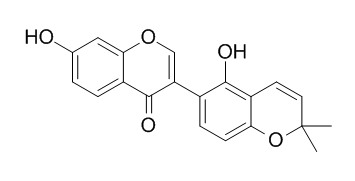Glabrone
Glabrone shows antiviral activity against influenza virus. It also exhibits significant PPAR-gamma ligand-binding activity.
Inquire / Order:
manager@chemfaces.com
Technical Inquiries:
service@chemfaces.com
Tel:
+86-27-84237783
Fax:
+86-27-84254680
Address:
1 Building, No. 83, CheCheng Rd., Wuhan Economic and Technological Development Zone, Wuhan, Hubei 430056, PRC
Providing storage is as stated on the product vial and the vial is kept tightly sealed, the product can be stored for up to
24 months(2-8C).
Wherever possible, you should prepare and use solutions on the same day. However, if you need to make up stock solutions in advance, we recommend that you store the solution as aliquots in tightly sealed vials at -20C. Generally, these will be useable for up to two weeks. Before use, and prior to opening the vial we recommend that you allow your product to equilibrate to room temperature for at least 1 hour.
Need more advice on solubility, usage and handling? Please email to: service@chemfaces.com
The packaging of the product may have turned upside down during transportation, resulting in the natural compounds adhering to the neck or cap of the vial. take the vial out of its packaging and gently shake to let the compounds fall to the bottom of the vial. for liquid products, centrifuge at 200-500 RPM to gather the liquid at the bottom of the vial. try to avoid loss or contamination during handling.
Molecules.2023, 28(8):3474.
Phytochem Anal.2023, pca.3305.
The Korea Journal of Herbology2020, 35(3):33-45.
Molecules.2017, 22(2)
Acta Edulis Fungi2020, 27(02):63-76.
Int J Mol Sci.2021, 22(19):10220.
Foods.2023, 12(19):3647.
Nutrients.2023, 15(13):2960.
Food Funct.2024, 15(8):4262-4275.
Horticulturae2024, 10(4), 382.
Related and Featured Products
J Nat Prod. 2014 Mar 28;77(3):563-70.
Computer-guided approach to access the anti-influenza activity of licorice constituents.[Pubmed:
24313801]
Neuraminidase (NA), a key enzyme in viral replication, is the first-line drug target to combat influenza.
METHODS AND RESULTS:
On the basis of a shape-focused virtual screening, the roots of Glycyrrhiza glabra (licorice) were identified as plant species with an accumulation of constituents that show 3D similarities to known influenza NA inhibitors (NAIs). Phytochemical investigation revealed 12 constituents identified as (E)-1-[2,4-dihydroxy-3-(3-methyl-2-butenyl)phenyl]-3-(8-hydroxy-2,2-dimethyl-2H-1-benzopyran-6-yl)-2-propen-1-one (1), 3,4-dihydro-8,8-dimethyl-2H,8H-benzo[1,2-b:3,4-b']dipyran-3-ol (2), biochanin B (3), glabrol (4), Glabrone (5), hispaglabridin B (6), licoflavone B (7), licorice glycoside B (8), licorice glycoside E (9), liquiritigenin (10), liquiritin (11), and prunin (12). Eleven of these constituents showed significant influenza virus NA inhibition in a chemiluminescence (CL)-based assay. Additional tests, including (i) a cell-based cytopathic effect inhibition assay (general antiviral activity), (ii) the evaluation of cytotoxicity, (iii) the inhibition of the NA of Clostridium perfringens (CL- and fluorescence (FL)-based assay), and (iv) the determination of self-fluorescence and quenching, provided further perspective on their anti-influenza virus potential, revealing possible assay interference problems and false-positive results.
CONCLUSIONS:
Compounds 1, 3, 5, and 6 showed antiviral activity, most likely caused by the inhibition of NA. Of these, compounds 1, 3, and 6 were highly ranked in shape-focused virtual screening.
Bioorg Med Chem. 2010 Jan 15;18(2):962-70.
Phenolics from Glycyrrhiza glabra roots and their PPAR-gamma ligand-binding activity.[Pubmed:
20022509 ]
METHODS AND RESULTS:
Bioassay-guided fractionation of the EtOH extract of licorice (Glycyrrhiza glabra roots), using a GAL-4-PPAR-gamma chimera assay method, resulted in the isolation of 39 phenolics, including 10 new compounds (1-10). The structures of the new compounds were determined by analysis of their spectroscopic data. Among the isolated compounds, 5'-formylglabridin (5), (2R,3R)-3,4',7-trihydroxy-3'-prenylflavane (7), echinatin, (3R)-2',3',7-trihydroxy-4'-methoxyisoflavan, kanzonol X, kanzonol W, shinpterocarpin, licoflavanone A, glabrol, shinflavanone, gancaonin L, and Glabrone all exhibited significant PPAR-gamma ligand-binding activity.
CONCLUSIONS:
The activity of these compounds at a sample concentration of 10microg/mL was three times more potent than that of 0.5microM troglitazone.



